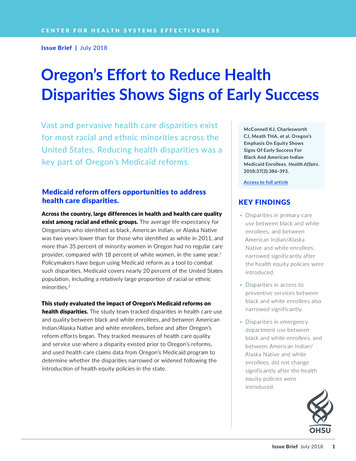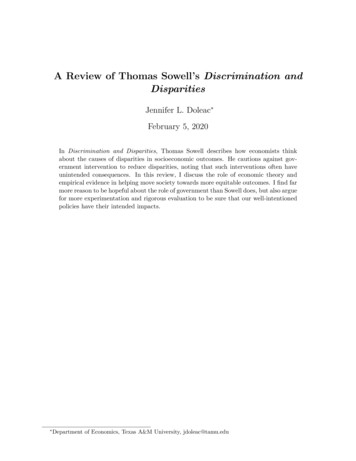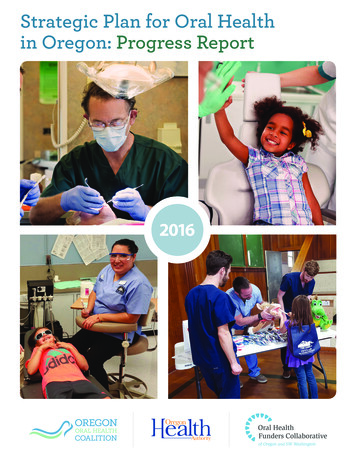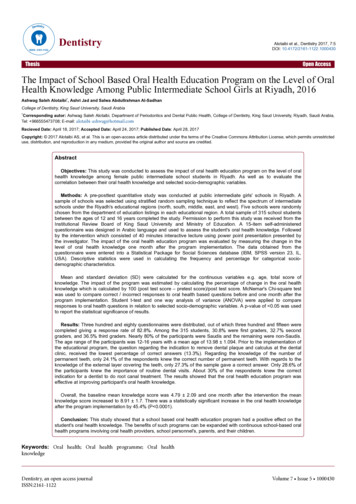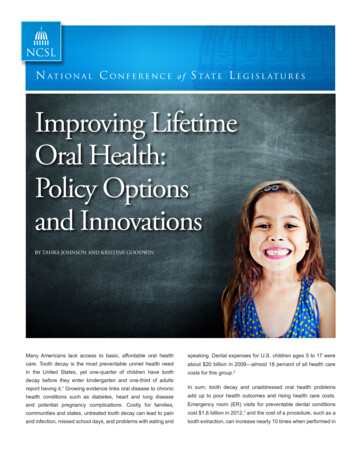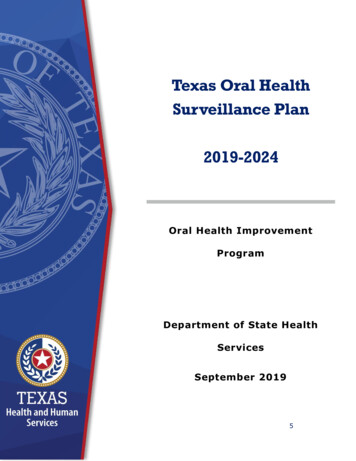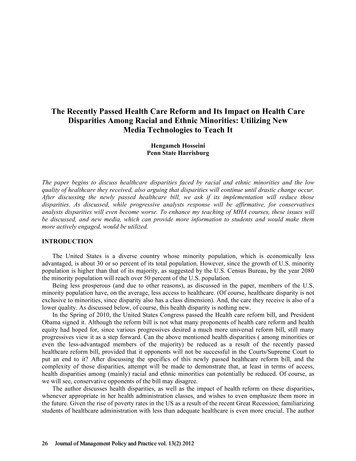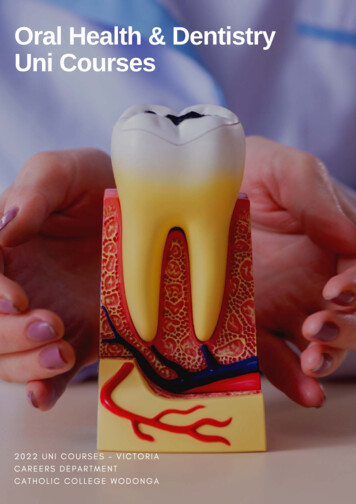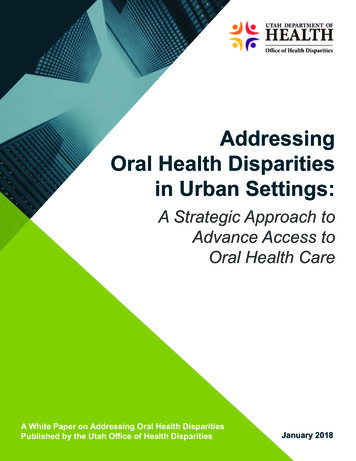
Transcription
AddressingOral Health Disparitiesin Urban Settings:A Strategic Approach toAdvance Access toOral Health CareA White Paper on Addressing Oral Health DisparitiesPublished by the Utah Office of Health DisparitiesJanuary 2018
Acknowledgments: This project is funded by the State Partnership Grant to Improve Minority Health(STTMP151108) from the Office of Minority Health, U.S. Department of Health and Human Services, 2015-2020.Suggested Citation: Office of Health Disparities. Addressing Oral Health Disparities in Urban Settings: AStrategic Approach to Advance Access to Oral Health Care. Salt Lake City (UT): Utah Department of Health,Office of Health Disparities; January 2018.This report is available at: health.utah.gov/disparities
TABLE OF CONTENTSGLOSSARY .4EXECUTIVE SUMMARY .5INTRODUCTION .6Background .6The State Partnership Initiative to Address Health Disparities .7ACCESS TO ORAL HEALTH CARE AND THE SOCIAL DETERMINANTS OFHEALTH .9Access to Care .9The Social Determinants of Health .9Access to Care and the Social Determinants of Health .10OHD EFFORTS TO ADDRESS ACCESS TO ORAL HEALTH SERVICES ANDDISPARITIES IN URBAN SETTINGS .12Guiding Principle .12Theoretical Framework .12Applying the Framework .14CONSIDERATIONS FOR PARTNERS .17Reaching Disparate Populations .17Adopting a Theoretical Framework .17SUMMARY .19REFERENCES .21
GlossaryHealth disparity: a difference in health outcomes linked to social, economic, geographic,cultural, or environmental disadvantage.Health equity: the principle underlying efforts to address health disparities; it means strivingfor the highest possible standard of health for all people.Social determinants of health (SDH): the conditions in which people are born, grow, work,live, and age, and the wider set of forces and systems shaping the conditions of daily life.Access to care: the timely use of personal health services to achieve the best health outcomes.Oral health: a state of being free from chronic mouth and facial pain, oral and throat cancer,oral sores, birth defects such as cleft lip and palate, periodontal (gum) disease, tooth decay andtooth loss, and other diseases and disorders that affect the oral cavity.Oral health services: preventive and dental services to prevent and control oral andcraniofacial disease, conditions, and injuries.Sources:Braveman, P. (2014). What Are Health Disparities and Health Equity? We Need to Be Clear. Public Health Reports,129(Supplement 2), 5-8. Retrieved from 49141291S203U.S. Department of Health and Human Services. (2017). Access to Health Services. Retrieved from Healthy People 2020Topics and Objectives: es/topic/Access-to-Health-ServicesU.S. Department of Health and Human Services. (2017). Oral Health. Retrieved from Healthy People 2020 Topics andObjectives: es/topic/oral-healthUS Department of Health and Human Services. (2000). Oral Health in America: A Report of the Surgeon General --ExecutiveSummary. Rockville, MD: US Department of Health and Human Services, National Institute of Dental and CraniofacialResearch, National Institutes of Health. Retrieved from neral/Report/ExecutiveSummary.htmWorld Health Organization. (2008). Closing the gap in a generation: Health equity through action on the social determinantsof health. Report from the Commission on Social Determinants of Health. Retrieved from n/finalreport/en/4Utah Office of Health Disparities White Paper 2018
EXECUTIVE SUMMARYOral health is integral to the overall health and well-being of individuals andcommunities.1 Oral health encompasses much more than healthy teeth.2 “Oralhealth affects our ability to speak, smile, eat, and show emotions. It also affectsself-esteem, school performance, and attendance at work and school.”3 Oraldisease burdens individuals and families with pain, disability, and financialstress.1,3Although considerable progress has been made overall in oral health, manygroups experience a “severe and disproportionate burden” of oral health disease.4These disparities vary by race and ethnicity, socio-economic status, age, gender,and geography.1,4,5 Oral health disparities are often a manifestation of underlyingdisparities in access to care influenced by social, economic, and environmentaldeterminants. Addressing access to care issues through the social determinants ofhealth is one way to begin addressing oral health disparities.Addressing accessto care issuesthrough the socialdeterminants ofhealth is one way tobegin addressing oralhealth disparities.This white paper outlines efforts to increase access to oral health care servicesin urban settings by addressing the social determinants of health. It describesthe importance of a strategic approach to address oral health disparities andsuggests utilizing the framework of the National Partnership for Action to EndHealth Disparities’ (NPA’s) goals. It encourages the adoption of approaches inthe areas of (1) awareness, (2) leadership, (3) health systems and life experience,(4) cultural and linguistic competency, and (5) data research and evaluation.6 Thepurpose of this paper is to promote strategic approaches that redirect the focus ofservices from short-term care to investments in solutions for long-term access tocare.This paper promotesstrategic approachesthat redirect thefocus of servicesfrom short-term careto investments insolutions for longterm access to care.The Office of Health Disparities (OHD) is committed to striving to reduceand ultimately eliminate health disparities, including oral health disparities,by addressing determinants. OHD aims to pursue health equity, which meansstriving for the highest possible standard of health for all people and giving specialattention to the needs of those communities at greatest risk for health disparities.Our vision is for all people to have a fair opportunity to reach their highest healthpotential given that health is crucial for well-being, longevity, and economic andsocial mobility.7 This white paper is an extension of OHD’s efforts to address oralhealth disparities and attempts to share with key stakeholders OHD’s experiences,findings, and expertise related to increasing access to oral health services in urbansettings.OHD invites allstakeholders toreduce oral healthdisparities in Utahby increasing andimproving accessto care throughaddressing the socialdeterminants ofhealth.OHD invites all interested and relevant stakeholders to join the efforts to reduceoral health disparities in Utah including increasing and improving access to carethrough addressing the social determinants of health. Eliminating oral healthdisparities will require strategic and collaborative statewide partnerships. Eachpartner can begin to address the social determinants of health through incrementalactions. Ultimately, the accumulated effort can reduce oral health disease anddisparities and advance Utahn’s oral health overall.Utah Office of Health Disparities White Paper 20185
INTRODUCTIONBackgroundDisparities in accessto care are linked todisparities in oralhealth outcomes.Access to oral health care services is integral to promoting the overall health andquality of life of individuals and communities. However, some individuals havelimited or no access to quality and comprehensive oral health care services.1,8 In2016, about 30% of Utah adults did not have a dental visit in the past year.9 Thisnumber worsened by as much as 10% when the individual did not have dentalinsurance. “People who have the least access to preventive services and dentaltreatment have greater rates of oral diseases.”10 Thus, disparities in access to careare linked to disparities in oral health outcomes.The most disparatepopulations accessoral health servicesat the lowest rates.How do we addressaccess to oral healthservices and oralhealth disparities forthese underservedpopulations?Access to care is complicated and multifaceted. Individuals trying to access oralhealth services can face an assortment of complex barriers. Insurance coverage,cost of services, availability of services, and availability of culturally andlinguistically appropriate services, are all factors influencing a person’s abilityto access care. These factors are often tied to a person’s social and economicstatuses. Accordingly, “a person’s ability to access oral health care [has beenfound to be] associated with education level, income, race, and ethnicity.”10Thus, the most disparate populations such as racial and ethnic minorities,limited-English proficient (LEP) individuals, people with disabilities, the elderly,children, rural and urban underserved residents, and uninsured and low incomeindividuals, are often accessing oral health services at the lowest rates.11-15 Barriersto accessing care can lead to unmet dental needs, delayed care, lack of preventiveservices, preventable emergency room visits, pain, disability, and economicburden.16 So, how do we address issues with access to oral health services and oralhealth disparities for these underserved populations?Approaches thatare systematic andcomprehensive, areideal for sustainablyaddressing oralhealth disparitiesand advancing healthequity, but alsorequire substantialpower, influence, time,and resources.In 2011, the Institute of Medicine and National Research Council produceda report commissioned by the Health Resources and Services Administration(HRSA) and the California Health-Care Foundation on “improving access to oralhealth care for vulnerable and underserved populations.”17 The report “call[ed] fortransformation through targeted investment in programs and policies that are mostlikely to yield the greatest impact.”17 These include (1) integrating oral healthcare into overall health care, (2) creating optional laws and regulations for scopeof-practice, (3) improved dental education and training, (4) reducing financialand administrative barriers, (5) promoting research for service delivery to thesepopulations, and (6) expanding capacity of state oral health programs. Theseapproaches are systematic and comprehensive, making them ideal for sustainablyaddressing oral health disparities and advancing health equity, but also requiresubstantial power, influence, time, and resources.6Utah Office of Health Disparities White Paper 2018
Accordingly, in the context where achieving one or more of these strategies iscurrently out of reach, can anything be done in the short-term to begin increasingaccess to oral health services while still working toward addressing oral healthdisparities? In Utah, a variety of providers, organizations, and programs haveemerged to respond to the dental needs of Utahns lacking access to affordablecare.18 These individuals and entities increase access to care by offering lowcost or free care to economically disadvantaged communities. These efforts haveincluded one-time access to care provided through volunteer efforts, sometimesviewed as being short-term, non-sustainable Band-Aid approaches. However,since joining these efforts, the Office of Health Disparities (OHD) has endeavoredto implement strategic activities that redirect the focus of services from short-termcare to investments in solutions for long-term access to care.In the context wherethese strategies iscurrently out of reach,can anything be donein the short-termto begin increasingaccess to oral healthservices while stillworking towardaddressing oral healthdisparities?The State Parternship Initiative to AddressHealth DisparitiesOne-time access tocare is viewed asa short-term, nonsustainable BandAid approach. OHDworks to redirectthe focus of servicesfrom short-term careto investments insolutions for longterm access to care.In August 2015, OHD joined the State Partnership Initiative to Address HealthDisparities (SPI) with the goal to “effectively improve health outcomes inselected geographical hotspots and address health disparities that affect minoritiesand disadvantaged populations.”19 Over a five year period, OHD will focus onimproving access to both medical and oral health services through its BridgingCommunities and Clinics (BCC) program in two of Utah’s most underservedurban communities: the neighborhood of Glendale and the City of South SaltLake.Utah Office of Health Disparities White Paper 20187
BCC is a community-based outreach program developed by the Office of HealthDisparities (OHD) designed to address known inadequacies and inefficienciesof the “traditional” health fair approach to community health outreach. Movingbeyond distribution of brochures and basic health screenings, the BCC approachaddresses themes of access to health services, preventive wellness promotion,and cultural competency. The BCC model (1) partners with community-basedorganizations to mobilize community members; (2) assembles a diverse trainedoutreach team; (3) provides free clinically relevant health and oral healthscreenings; (4) securely collects data on social determinants of health needs; (5)offers appropriate referrals; and (6) works with a network of organizations todeliver individualized post-screening follow-up.OHD hosts free dentalday clinics to increaseaccess to oral healthcare for individualsscreened through theBCC program.In August 2016, OHD began hosting free dental day clinics to further increaseaccess to oral health care for those outreached and screened through the BCCprogram. OHD, in collaboration with the Family Dental Plan’s (FDP) SaltLake clinic and the Oral Health Program (OHP), secures the facility space andequipment, coordinates providers and volunteers, schedules patients, arranges forinterpretation services, and offers referral care options. The free dental day clinicsprovide one-day dental care access at no cost to the patient. OHD has hosted sixclinics and provided care to more than 400 patients.OHD aims to ensure that its short-term access to oral health services hassustainable components that ultimately address oral health disparities.Accordingly, OHD’s free dental day clinics build upon the National Partnershipfor Action to End Health Disparities’ (NPA’s) goals: (1) awareness, (2) leadership,(3) health system and life experience, (4) cultural and linguistic competency, and(5) data research and evaluation.This paper raisesawareness aboutdisparities in accessto oral health care inUtah and proposes astrategic frameworkto apply to short-termaccess to care asmeans to address oralhealth disparities.This white paper builds on OHD’s efforts to increase access to oral healthservices and address oral health disparities by sharing with stakeholders OHD’sexperiences, findings, and expertise related to providing short-term access to oralhealth services in urban settings. It describes factors and short-term solutionsin access to oral health care services, which address the social determinants ofhealth. The purpose of this paper is to raise awareness about disparities in accessto oral health care in Utah and propose a strategic framework to apply to shortterm access to care as means to increase access in a way that addresses oral healthdisparities.The intended audience for the white paper includes all relevant stakeholdersinterested in addressing oral health disparities in Utah.8Utah Office of Health Disparities White Paper 2018
Access to Care and the SocialDeterminants of HealthAccess to CareDefinitionAccess to health services, including oral health services, is “the timely use ofpersonal health services to achieve the best health outcomes.”20Achieving quality and comprehensive access requires (1) entry into the healthsystem, (2) access to a location that provides services, and (3) access to a trustedprovider who can communicate with the patient. Thus, barriers like high costs ofservices, limited or no insurance coverage, proximity of services, clinic hours, orlack of culturally and linguistically appropriate care often disrupt access to care.8Achieving quality andcomprehensive accessrequires (1) entry intothe health system, (2)access to a locationthat provides services,and (3) access to atrusted provider whocan communicate withthe patient.The Social Determinants of HealthDefinitionThe social determinants of health are “the conditions in which people are born,grow, work, live and age, and the wider set of forces and systems shaping theconditions of daily life.”21The socialdeterminants of healthare shaped by thedistribution of money,power and resources.The social determinants of health are a collection of complicated socialand economic structures and systems embedded within social and physicalenvironments, which influence our health, functions, and quality of life.22 “[They]are shaped by the distribution of money, power and resources at global, nationaland local levels.”23 Examples of some social determinants of health includehousing, education, environment, health care, employment, transportation, andfood security.PICTUREPICTUREUtah Office of Health Disparities White Paper 20189
Access to Care and the Social Determinantsof HealthA person’s abilityto access healthservices, includingoral health services,is largely determinedby social andeconomic advantage.A person’s ability to access health services, including oral health services, islargely determined by social and economic advantage. The inability to enter thehealth system, access a location to receive services, and access a trusted provider,is often determined by underlying social, economic, and environmental factors.Thus, “access to care often varies based on race, ethnicity, socioeconomic status,age, sex, disability status, sexual orientation, gender identity, and residentiallocation.”5,11-15Entry into the Health SystemInsurance statusand the ability tocover the costs ofdental services isoften determined bysocio-economic statusincluding income,age, employmentstatus, immigrationstatus, and healthliteracy.In the United States and in Utah, dental insurance coverage is the conventionalgateway to entering the oral health care system. Many individuals have medicalinsurance but lack dental insurance and a limited number of dental providersaccept publicly-sponsored health insurance such as Medicaid or the Children’sHealth Insurance Program (CHIP).24 Furthermore, many individuals are uninsuredor underinsured, meaning the high cost of care prevents or limits access toservices.25 Subsequently, dentally uninsured or underinsured individuals “receivefewer dental services” than adequately insured individuals and are more likelyto experience poor oral health.14 Yet, insurance status and the ability to cover thecosts of dental services is often determined by socio-economic status includingincome, age, employment status, immigration status, health literacy, and languageability to fill out insurance forms.26Access to ServicesWhere an individualresides and workscan improve or limitaccess to oral healthservices. This is oftendetermined by incomeand employment,which are in partdetermined byeducation, race orethnicity, culture, age,disability, and familysize.10Access to oral health care requires a provider or facility in order to receive oralhealth services. Individuals with an accessible and usual source of care oftenexperience better health outcomes and lower financial burden.27,28 Accessing alocation for services depends greatly on geographic availability and hours ofoperation. Market forces often determine the distribution of dental professionals,clinic hours, and transportation options.29 Often, rural areas face health careprofessional shortages and lack the infrastructure for public transportation.30Urban areas also experience a lack of providers in certain neighborhoods andgaps in access to public transportation.31 Often clinic hours do not accommodateindividuals who cannot take time off work during the day or week, which can leadto either delay in care or loss of employment.1 Thus, where an individual residesand works can improve or limit access to oral health services. However, housingcircumstances are often determined by income and employment, which are inpart determined by education, race or ethnicity, culture, age, disability, and familysize.32,33Utah Office of Health Disparities White Paper 2018
Access to a Trusted ProviderHaving a trusted provider with whom patients can communicate is essential toaccessing care. This personal relationship can encourage or discourage use ofcare and is largely affected by “doctor-patient communications, including culturaland linguistic competency of care providers.”34 Unfortunately, some individualsare deterred from accessing care because of language and cultural barriers. Forexample, children from non-English-speaking households were less likely toaccess oral health services than children from English-speaking households.35In fact, in the United States, “access improves with acculturation and learningEnglish.”36 Culture gaps between providers and patients often exist due tocultural and linguistic differences, but also differences in social classes based oneducation, income, gender, and employment.4Access to oral health services is essential to promoting and maintaining the oralhealth and overall health and well-being of individuals and communities. Barriersto accessing care can lead to preventable disease, prolonged pain and unmetdental needs, postponed care, preventable emergency room visits, and financialstress.1 The social determinants of health influence access to timely, quality dentalcare services and, if not addressed, perpetuate disparities in oral health care andoutcomes.Utah Office of Health Disparities White Paper 2018Culture gaps betweenproviders andpatients often existdue to cultural andlinguistic differences,but also differencesin social classesbased on education,income, gender, andemployment.The socialdeterminants of healthinfluence access totimely, quality dentalcare services and,if not addressed,perpetuate disparitiesin oral health care andoutcomes.11
OHD EFFORTS TO ADDRESSACCESS TO ORAL HEALTHSERVICES AND DISPARITIES INURBAN SETTINGSOHD’s approachdrives the focus fromproviding short-termservices to developingsustainable,systematic solutionsfor long-term accessto care.OHD provides short-term increased access to oral health services for disparatepopulations living in urban settings through its free dental day clinics. OHD’sstrategic approach includes providing entry into the health system, accessto services, and access to a trusted provider by addressing social, economic,geographic, cultural, and linguistic barriers. OHD’s emphasis on the socialdeterminants of health increases the likelihood of encountering and servingdisparate populations, which is essential to reducing oral health disparities.OHD’s approach also includes strategic investments in the health literacy of thesecommunities as well as growing the capacity of the oral health workforce to servedisparate populations. This approach drives the focus from providing short-termservices to developing sustainable, systematic solutions for long-term access tocare.Guiding PrincipleOHD aims to advance oral health equity. Advancing oral health equity meansworking toward the “highest possible standard of [oral] health for all people.”37Strategies that increase access to oral health care for underserved communitiesreduce disparities and when those strategies are focused on eliminating barriersand addressing the social determinants of health, they pursue the advancement ofhealth equity.Theoretical FrameworkThe National Partnership for Action to End Health Disparities (NPA) was createdto “mobilize a nationwide, comprehensive, community-driven, and sustainedapproach to combating health disparities and to move the nation toward achievinghealth equity.”6 The NPA’s goals include (1) awareness, (2) leadership, (3) healthsystem and life experience, (4) cultural and linguistic competency, and (5) dataresearch and evaluation. The goals focus on understanding and addressing healthdisparities through the social determinants of health.12Utah Office of Health Disparities White Paper 2018
Source: es.jpgAwareness: Increase awareness of the significance of health disparities,their impact on the nation, and the actions necessary to improve healthoutcomes for racial, ethnic, and underserved populations.Leadership: Strengthen and broaden leadership for addressing healthdisparities at all levels.Health System and Life Experience: Improve health and healthcareoutcomes for racial, ethnic, and underserved populations.Cultural and Linguistic Competency: Improve cultural and linguisticcompetency and the diversity of the health-related workforce.Data Research and Evaluation: Improve data availability andcoordination, utilization, and diffusion of research and evaluationoutcomes.Utah Office of Health Disparities White Paper 201813
Applying the FrameworkThe NPA’s goals guide OHD’s efforts for the free dental day clinics. Within thisframework, OHD increases access to oral health care by providing entry intothe health system, access to services, and access to a trusted provider. This isaccomplished by addressing the social determinants of health linked to accessto care. Ultimately, OHD applies the NPA framework to redirect the focus of itsfree dental days from providing temporary services to engaging in efforts to buildsustainable components of access to care for underserved populations.Through thecombined expertiseof its collaborativepartnerships and thefirst-hand exposuregained through thefree dental clinics,OHD achieves amore comprehensiveapproach toincreasing awarenessof oral healthdisparities.The exchange ofexpertise betweenthe community andproviders is criticalto comprehensivelycultivating theleadership toaddress oral healthdisparities.14Awareness: Increasing awareness of the oral health disparities, theirimpact, and the actions necessary to improve health outcomes for racial,ethnic, and underserved populations is an important initial step toaddressing the disparities. OHD relies on an array of diverse partners for thecoordination of the free dental day clinics including representatives fromthe communities served and the oral health community. OHD collaborateswith these partners to understand the context of oral health disparities,develop effective strategies to address the social determinants of health, andappropriately modify oral health services rendered. Ultimately, during thefree dental day, each partner gains a refined understanding of the severityand complexity of oral health disparities in Utah. Through the combinedexpertise of its collaborative partnerships and the first-hand exposuregained through the free dental clinics, OHD achieves a more comprehensiveapproach to increasing awareness of oral health disparities and enhancingunderstanding of how to address them.Leadership: Strengthening and broadening leadership at all levels isfundamental to addressing health disparities. In preparation for the freedental clinic days, OHD considers the strengths and assets of each partnerinvolved and strategically employs their expertise. Over time, OHD hasfacilitated the exchange of expertise between the community and providersby explaining processes and providing community feedback. This increasesthe capacity of community leaders to instruct the community on oral healthcare practices and helps providers tailor care to underserved communities.It ultimately bridges the social, cultural, and economic gaps betweencommunities and providers. OHD believes this exchange of expertisebetween the community and providers is critical to comprehensivelycultivating the leadership to address oral health disparities.Utah Office of Health Disparities White Paper 2018
Health System and Life Experience: Improving the health andhealthcare outcomes for racial, ethnic, and underserved populations is keyto reducing health disparities and achieving health equity. During the freedental day clinics, OHD directly improves the oral health
social mobility.7 is white paper is an extension of OHD's e orts to address oral health disparities and attempts to share with key stakeholders OHD's experiences, ndings, and expertise related to increasing access to oral health services in urban settings. OHD invites all interested and relevant stakeholders to join the eff orts to reduce
